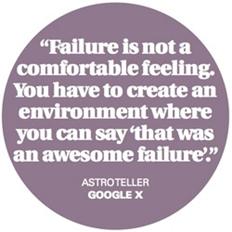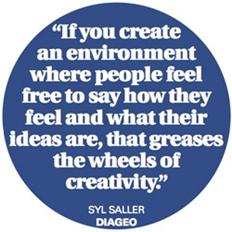Put your brand on the line
Creating a culture where experimenting is seen as vital and failure is not frowned upon can help brands make radical progress and boost success.
“Failure is the only way to make radical progress,” said Google’s Astro Teller at last month’s Cannes Lions International Festival of Creativity. Teller, who runs Google X, the innovation lab behind Google Glass and Google’s self-driving car, says that most of what it generates is rejected.
“The vast majority of ideas are killed off early – we try to stop them getting too big. Failure is not a comfortable feeling. You have to create an environment in which you can say ‘that was an awesome failure’.
Companies including Tata Communications, Diageo and Yahoo! are all considering how to approach failure and why mastering it is fundamental to a brand’s ability to innovate and stay ahead of the competition.
But fear of wasting time, money and losing a job might hold marketers back from trying things out. Coca-Cola’s Dasani mineral water, for example, was withdrawn from the UK in 2004 after the formulation was found to contain potentially harmful levels of bromate. And McDonald’s Arch Deluxe burger failed to appeal to its audience when it was launched in the late-1990s despite a reported $150m advertising campaign.
However, creating a culture where failure is accepted and used as a launchpad for ideas can boost a brand. In the 1960s, car rental company Avis launched the phrase ‘We’re number 2. We try harder’ to take on market leader Hertz. The idea was risky because it highlighted the fact that it was not number one, but it worked and ran until last year, boosting turnover for Avis.

The challenge for marketers is not to avoid failure but learn how to fail in the right way, says Unilever chief marketing officer Keith Weed. “Repeated failure is not a good thing and too much failure is not a good thing but you have to have enough to learn from,” he says.
“Experimentation is important and along with that comes failure. By definition, if you’re not failing, you’re not trying hard enough. Throughout our lives, we’re taught that it’s important to be right and successful and if you get things wrong it’s bad, so people pull away from that.”
He says that Unilever’s Dove campaign for real beauty was not right initially. “In the early stages, there was a phase when the imagery got ahead of the product. There started to be a disconnect between the imagery and the offerings of the product, so we corrected that and now of course
it works well.”
Other innovations might bomb in one environment but fly in another, says Diageo CMO Syl Saller. When the company launched Surger – a device that helps provide the ‘perfect’ pint of Guinness – to the off-trade, people shopping in supermarkets simply did not understand why they needed it.
“We tried selling it through Tesco to people in the home, but consumers didn’t really know what to do with it,” she explains. So, Diageo decided to roll it out to 20,000 pubs in Britain that were not large enough to store kegs of Guinness and in doing so extended its on-trade footprint considerably.
“When we do fail, it’s fine,” says Saller. “The internal chat goes something like: ‘it’s fine and what did you learn?’ We probably don’t fail that much. Sometimes I wonder if we are taking enough risk.”
Diageo has clearly learnt from its failures – with 73 per cent of its products in the US still in market five years after launch, compared with a category average of 32 per cent, the company claims.
Saller also says its ready-to-drink, fruit-based alcoholic product Quinn’s was a failure. Diageo axed it in 2007, although in testing it ‘scored off the charts’. “We thought ‘great’ and launched it. But it then failed big in Britain. What we learned was the importance of live testing.”

Giving staff permission to fail means they are more likely to take risks and eventually come up with mould-breaking ideas such as Red Bull’s live online Stratos Jump (above), and Google X’s Google Glass (below)
It can be easier for other types of companies to fail and recover than it is for more established consumer goods companies. ‘Fail Fast’ is a term coined in Silicon Valley, suggesting that failing before the project gets too big and expensive is imperative to mastering failure.
Digital platforms such as YouTube provide ever more opportunities for experimentation by marketers. Benjamin Faes, managing director of new products and solutions, northern Europe, at YouTube, cites Dove’s Real Beauty Sketches, Red Bull’s live online Stratos Jump and Topshop’s live-streamed fashion show as examples of brands taking risks and breaking the mould online.
He says: “In the current economic climate, money spent on experimenting is risky. In big companies, with big campaigns, [the decisions to do so] come from the top.”
The ability to refine things you do not get right the first time is critical. Yahoo! senior director Robert Bridge says one of the beauties of digital marketing is you can see data in real time. “If the strategy is totally wrong then it is difficult to change that but the digital world does allow you to test and mess with stuff. It’s incredible now when you’re A/B testing, how changing colours and pixels can make a difference.”
Tata Communications, the telecommunications arm of the Indian conglomerate, is fostering a culture that embraces experimentation. It has introduced a reward for failure to encourage staff to feel comfortable taking measured risks. In addition to celebrating the best innovation in the company every year, the company gives a big cash prize for the failure that they learned the most from, explains CMO Julie Woods-Moss.

“Mistakes happen. Instead of getting upset about it we ask ‘what can we do?’ And that is the culture from the top. We would rather have a mistake happen, work it out and move on, than be a company tied up in bureaucratic processes.”
Similarly, Yahoo!’s marketing team has just launched a ‘Fail Forward’ award, given every quarter. “The global team has to submit examples of where we’ve failed and we give an award to the people who have tried something bold that has not succeeded,” says Bridge.
Similar openness comes from eBay’s Eben Sermon, director of relationship marketing and loyalty. Speaking at last month’s Marketing Week Live he explained that its partnership with Nectar is the brand’s third attempt at loyalty.
Regarding a previous attempt, he said: “People were relatively apathetic, they were earning relatively small rewards and it had very negative return on investment. I’m fortunate to work in an organisation that welcomes fast failures. You need to get stuff wrong before you make progress, which was our experience with loyalty.”
Fujitsu marketing director Simon Carter cites the BBC as a brand that has learned this lesson the hard way. In May, the broadcaster scrapped a multi-million-pound project to create an internal digital production system The Digital Media Initiative, which has cost £98.4m since it started in 2008.
“Ambitious technology projects like this always carry a risk of failure. It does not mean we should not attempt them but we have a responsibility to keep them under much greater control than we did here,” said BBC director general Tony Hall.
A company’s attitude to failure will ultimately dictate how creative it will be. “I find it interesting that often what people are most afraid of is not big failure that is going to lose the company millions because there are plenty of things in place to stop that from happening,” says Saller at Diageo. “They are afraid of going with a bold idea and nobody going with them, and the personal risk that’s attached to that. If you can create an environment where people feel really free to say how they feel and what their ideas are, that greases the wheels of creativity.”
Google X’s Teller agrees that giving people the freedom to explore ideas in a nurturing environment is critical to the emergence of game-changing ideas. “The thing that excites me most isn’t Google Glass or self-driving cars, it’s that I think we can do it over and over again. I have an incredible group of Peter Pans with PhDs. If I try to organise them too much, the magic will leave the building.”

More companies are formalising the process of letting employees be creative and with positive effect, according to Ryan Tate, author of The 20% Doctrine: How Tinkering, Goofing Off, and Breaking the Rules at Work Drive Success in Business (see viewpoint, right). The book catalogues a range of businesses that are encouraging innovation in this way.
Google and its creation of the 20 per cent programme, where employees are encouraged to spend a proportion of their working week on special projects is probably the most famous example.
“The spirit of it – the idea that Googlers are empowered to run with their ideas and contribute in a meaningful way to different projects around the company – is core to our culture,” says Zayna Aston, communications manager at Google.
“We have found that this sort of innovation is a critical driver in Google’s development of innovative ideas and products including Google News, GMail, Google Talk, Mars in Google Earth and various Android applications.”
LinkedIn launched Incubator last year, which allows employees to pitch new ideas to senior executives. If approved, the team is allowed time to dedicate to turning their idea into a reality (see case study).
These processes are bringing the spirit of start-up back to big, established brands. “For me, an even bigger theme than acceptance of failure, which feels a bit tired, is about operating like an entrepreneur or a founder,” says Saller.
Giles Jepson, CMO at Heinz UK & Ireland, agrees: “Failure is accepted, as long as the same mistake is not made twice. Learning quickly and cheaply and applying the learnings is critical.”









